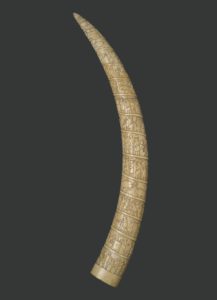Elephants are adorable plant-eating creatures beloved by most all. Seen as intelligent and family-centric, the admiration for elephants, and their perceived abuse documented by animal rights activists led to the recent closure of the Ringling Bros. and Barnum & Bailey Circus after 146 years under the Big Top. The prevailing sentiment advanced by People for the Ethical Treatment of Animals (PETA) is that “any use of an animal by a human is abuse.”
The sad news is that high demand stemming mostly from China for ivory products continues to fuel elephant poaching, regardless of the Convention on International Trade in Endangered Species of Wild Flora and Fauna (CITES) international ban on commercial trade in African elephant ivory established in 1990. Humane Society International (HIS) reports that 100 elephants are killed daily for their tusks. Driving the trade are African militia groups in the Sudan, Uganda, and Somalia that profit from harvesting ivory to fund local terrorism.

Of interest to this case, before the 1990 CITES ban, the market for elephant ivory comprised chiefly of carvings sold in Asia whereas in the U.S. and Europe, ivory was used in jewelry making. China continues to be the largest market for ivory products, followed by the U.S. Some estimate that 90 percent of ivory sold in China is from smuggled tusks.
Against this highly complex backdrop, Enservio Select was recently called upon to perform the difficult task of assigning value and providing a true retail replacement cost for a potentially illegal, carved African elephant tusk and custom stand.
A description provided by the claimant and a third-party appraisal characterized the item as a 72-inch (six foot) elephant tusk, either first or second quarter 20th century, having two reign or seal marks, and intricate carvings on both sides. The carving was described as showing “the immortals riding a foo dog, an elk, an elephant, a horse, a dragon, and other large creatures” on a conforming reticulated teakwood stand.
The description added, “This is probably among the finest large tusks that have been on the market for years.” The initial claim was cited at $500,000, based on the original appraiser’s “ultimate” retail value. When asked for supporting valuation, it appeared that none was readily available.
Photos of the tusk and stand were provided, including a single pre-loss photograph and several post-loss photos. A third-party appraisal by a professional group was also on hand, creating a good starting point in the investigation.
Enservio reached out to the insured’s private adjuster to learn how the insured procured the item. The team was informed that the tusk and stand were given as a gift to the insured.
Legally speaking, the CITES Ivory ban would strictly forbid the sale of post-ban procured elephant ivory of this form.
For purposes of this evaluation, the team made the extraordinary assumptions that the animal tusk was harvested in the early first quarter of the 20th century, carved overseas and imported into the U.S. long prior to all CITES ban restrictions. Based on the reported history of the tusk, the piece was assumed to be over 100 years old.
The original appraiser described the item as an African ivory tusk. However, based on close analysis of the carving motif itself, Enservio determined that the tusk was more likely to have been harvested from an Asian elephant, being then afterwards carved by a Chinese artist or craftsman. No close-up photos of the actual “reign or seal marks” were provided, or provenance pertaining to the actual carver.
The size of the tusk is significant at 72-inches, although many antique worked tusks bearing these proportions have been sold in the past. The current scrutiny of elephant ivory sales limits the number of available examples in the open market today.
Enservio research revealed previous sales of similarly carved ivory tusks, including a slightly larger, intricately carved, first quarter 20th century Chinese tusk, which sold with its carved display stand for $20,000 at auction.
The photos of the carving were of limited quality however the carvings appeared to be more in line with Asian inspired themes, which supported the premise that the ivory tusk was more likely Asian rather than of African descent.
The team viewed many other past sales of carved tusks as part of its research. Sizes, motifs and ages all varied, but historical sales were analyzed and considered as part of the team’s analysis and vintage retail replacement valuation.
Although a reasonable fair market value would fall in the $20,000 to $30,000 range for the stand and tusk, the dealer mark-up was factored, along with scarcity in the market.
Based on historical auction sales data, an understanding of the current complex vintage retail market, including consultations with antique dealers, auctioneers, and other antique appraisers, the team concluded a $60,000 value as fair and reasonable vintage replacement value for the carved ivory tusk and stand, a $440,000 delta from the initial claimed value of $500,000.
In November 2013, in an act to show compliance with CITES, with much fanfare the United States government destroyed a six-ton stockpile of its confiscated ivory. The event was intended to send two messages: That illicit ivory has no value in the U.S., and secondly, to set an example on the world stage for other countries to follow suit, and put an end to the illegal trade. China and Hong Kong followed example and conducted the same act in what was considered “a win” for threatened elephants worldwide.
Steve Leone is a review appraiser for Enservio (www.enservio.com), a provider of contents claim management software, payments solutions, inventory and valuation services for property insurers. He has held auctioneer positions at Leone Auctions, Cole auctions, Abdou auctions, Flanagan Auction Gallery, Carver Auction Gallery and the Stutz Blacker Auction Company. Steve’s knowledge of antiques and collectibles includes estate silver, porcelain, custom and antique knives, edged weapons, antique firearms, antique clocks, antique furniture and collectibles of all types.
Other articles by Steve Leone:
Was this article valuable?
Here are more articles you may enjoy.

 ‘Surface Waters’ on Roof Are Not ‘Flood’ Waters, Massachusetts High Court Rules
‘Surface Waters’ on Roof Are Not ‘Flood’ Waters, Massachusetts High Court Rules  U.S. Severe Storms Continue to Drive Global Natural Disaster Losses: Gallagher Re
U.S. Severe Storms Continue to Drive Global Natural Disaster Losses: Gallagher Re  J&J Loses Latest Legal Bid to Revive Talc Bankruptcy Strategy
J&J Loses Latest Legal Bid to Revive Talc Bankruptcy Strategy  CrowdStrike’s Tests Failed to Flag Bug Behind Epic Crash
CrowdStrike’s Tests Failed to Flag Bug Behind Epic Crash 